Why using a 401(k) to pay for emergencies is hurting employers and employees
More and more employees are withdrawing $1,000 or less from their 401(k) retirement accounts to help pay for emergency expenses according to HR leaders. This trend is causing corporate leaders to become concerned about the financial stress that their employees are living with. Read the following blog post to learn more.
More than ever, HR leaders at Fortune 500 companies are reporting that employees are withdrawing $1,000 or less from their hard-earned 401(k) retirement accounts to pay for emergency expenses. These employees — often living at the brink of being financially unstable — are using the funds for unexpected emergency expenses like car repairs, medical bills or even to purchase books for their college-age children.
Corporate leaders are now, more than ever, concerned that many of their employees live under a high degree of financial stress that can affect their productivity, creativity and even their health, resulting in absenteeism and drops in productivity that ultimately impact the bottom line. HR managers are especially feeling the pain as they are called upon to handle the excessive paperwork needed for the 401(k) plan withdrawals, causing extra work that could be spent more productively on other projects that benefit all employees.
The fact that more Americans than ever are dipping into their 401(k) accounts for emergency funds reveals that many are living above their means or working below their needs financially. While it’s important to have an emergency fund, for many people savings is a luxury they simply can’t afford. According to a Federal Reserve survey, nearly 40 percent of Americans said they don’t have enough cash on hand to cover an unexpected $400 expense. The quick fix for many is to use credit cards or ask family or friends for a loan when an emergency arises, but when those are not options, tapping into the 401(k) accounts is becoming increasingly common.
Some companies are partnering with payday loan companies so employees will refrain from tapping into their retirement funds. This is actually a worse idea because they’re setting their employees up to fail by enabling a vicious cycle of debt employees may never be free of.
Financial education could be the key to helping employees gain control of their financial lives. Companies that promote financial literacy courses and attendance at financial seminars or conferences offer the first step toward a better path for future financial stability. Offering or subsidizing the cost of continuing education courses help inspire employees to begin a lifelong journey of education for higher salaries and career advancement. Companies that promote education and career advancement attract, engage and retain employees longer than companies that don’t.
Flexible benefits can help
Companies can help their employees refrain from using their 401(k) retirement accounts as a bank if they offer flexible benefits. Employees get to choose how to use their earned benefits, like utilizing the monetary value of their unused paid time off (PTO) for other priorities such as paying for an emergency expense, paying down student loan debt or funding a vacation, among other things. Companies that offer flexible benefits are giving workers the ability to finally be in the driver’s seat of their careers and lives. When companies empower employees in this way, job satisfaction, productivity and creativity go way up.
Flexible benefits are a no brainer to organizations that want to attract, recruit, engage and retain top talent. Salary isn’t the only factor in determining a good career move, and companies that want to win the talent war will offer some type of flexible benefits. Every employee should have the ability to choose benefits based on their individual needs, avoiding the damaging financial practice of using 401(k) accounts for emergency expenses.
SOURCE: Whalen, R. (25 November 2019) "Why using a 401(k) to pay for emergencies is hurting employers and employees" (Web Blog Post). Retrieved from https://www.benefitnews.com/opinion/employees-are-using-401k-funds-for-emergencies
IRS increases retirement contributions for 2020
Recently, the Internal Revenue Service (IRS) announced that workers contributing to 401(k), 403(b), 457 and the federal government’s Thrift Savings Plans will be able to add up to $19,500 in 2020. Read this blog post to learn more about this increase in retirement contributions.
The IRS said this week that workers contributing to 401(k), 403(b), 457 and the federal government’s Thrift Savings Plans plans can add $19,500 next year, an increase from $19,000 in 2019.
The move could help workers save more for retirement, but it may be inconvenient for employers who’ve already started open enrollment, experts say. Employees are now able to set aside $500 more for retirement.
“Every penny counts when you’re saving for retirement, and the higher contribution limit is definitely going to help,” says Jacob Mattinson, partner at McDermott, Will & Emery, a Chicago-based law firm. “But since companies are in the midst of open enrollment, employers may have to go back in and change the entries for employees who want to contribute the max.”
There are about 27.1 million 401(k) plan participants using roughly 110,794 employer-sponsored 401(k) plans, the Employee Benefit Research Institute says. Ninety-three percent of employers offer a 401(k) plan, and around 74% of companies match workers’ contributions, according to data from the Society for Human Resource Management.
While the vast majority of employers do offer retirement savings plans, employees may still be struggling to sock away money. Around 70% of workers say debt has negatively impacted their ability to save for retirement, EBRI says.
“Thirty-two percent of workers with a major debt problem are not at all confident about their prospects for a financially secure retirement, compared with 5% of workers without a debt problem,” says Craig Copeland, EBRI senior research associate.
The IRS also upped contribution limits on Savings Incentive Match Plan for Employees plans, or SIMPLE retirement accounts, to $13,500 from $13,000. The agency did not change the contribution limits to IRAs, which remain at $6,000 annually.
SOURCE: Hroncich, C. (7 November 2019) "IRS increases retirement contributions for 2020" (Web Blog Post). Retrieved from https://www.benefitnews.com/news/irs-increases-retirement-contributions-for-2020
A 401(k) plan administrators’ guide to the recent IRS revenue ruling
The IRS recently released a new revenue ruling that provides 401(k) plan administrators with helpful guidance on reporting and withholding from 401(k) plan distributions. Read the blog post below to learn more about this new ruling.
The IRS recently issued revenue ruling 2019-19. The revenue ruling provides 401(k) plan administrators with helpful guidance on how to report and withhold from 401(k) plan distributions when a plan participant actually receives the distribution but for some reason, does not cash the check.
Unfortunately, this new guidance does not provide answers to the complex issues that 401(k) plan administrators face when the plan must make a distribution, but the plan participant is missing.
Let’s hope revenue ruling 2019-19 is just the first in a series of much-needed guidance from the IRS and the Department of Labor about how 401(k) plan administrators should handle the increasingly common administrative issues related to uncashed checks and missing plan participants.
There are many situations in which a 401(k) plan must make a distribution to a plan participant. For example, plans must distribute small benefit cash outs (e.g., account balances that are $1,000 or less) or required minimum distributions to plan participants who reach age 70 and a half. This may come as a surprise, but plan participants fail to actually cash these checks with some regularity.
In the ruling, the IRS confirmed that 401(k) plan administrators should withhold taxes on a 401(k) plan distribution and report the distribution on a Form 1099-R in the year the check is distributed to the participant, even if the participant does not cash the check until a later year.
Similarly, the participant needs to include the plan distribution as taxable income in the year in which the plan makes the distribution even if the participant fails to cash the check until a later year. While this guidance is not surprising, it does provide clarity to 401(k) plan administrators as to how they must withhold and report normal course and required plan distributions. In particular, 401(k) plan administrators should not reverse the tax withholding or reporting of the distribution when the participant receives the distribution and simply does not cash the check until a later year.
Unfortunately, this new IRS guidance has limited use because the ruling uses an example that specifically concedes that the plan participant actually received the plan distribution check, but simply failed to cash it. What should 401(k) plan administrators do when the participant may not have received the distribution check at all (e.g., a check is returned for an invalid address) or the plan itself does not have current contact information for the participant?
Retirement plan administrators have an ERISA fiduciary obligation to implement a diligent and prudent process to find missing plan participants and to take additional steps to make sure participants actually receive plan distributions. Uncashed 401(k) plan distribution checks are still retirement plan assets which means the 401(k) plan administrator is still subject to ERISA fiduciary standards of care, prudence and diligence related to those amounts. As a result, the IRS and DOL have increased their focus on uncashed checks and missing participants in retirement plan audits.
Plan administrators would be well-served by establishing and implementing a consistent process to stay on top of any missing plan participants or uncashed checks and taking steps to locate those participants and properly address uncashed checks. Plan administrators should also carefully document the steps that they take in this regard. The IRS and DOL have currently provided limited guidance on the steps a 401(k) plan administrator can take to locate missing participants, but more guidance is needed — let’s hope revenue ruling 2019-19 is just the beginning.
This article originally appeared on the Foley & Lardner website. The information in this legal alert is for educational purposes only and should not be taken as specific legal advice.
SOURCE: Dreyfus Bardunias, K. (6 September 2019) "A 401(k) plan administrators’ guide to the recent IRS revenue ruling" (Web Blog Post). Retrieved from https://www.benefitnews.com/opinion/401k-administrators-guide-to-the-irs-revenue-ruling-2019-19
Move over, financial wellness. It’s time for financial flexibility
Are your employees stressed out about their personal finances? Many find it hard to believe that a majority of employees live paycheck-to-paycheck, despite the fact that most Americans have recovered from the Great Recession. Continue reading to learn about financial flexibility.
It’s somewhat hard to believe that most employees today continue to live paycheck-to-paycheck. Despite the fact that Americans have recovered from the Great Recession a decade ago and that the unemployment rate is the lowest it has been in many years, employees are essentially making the same amount of money they did during the pre-recession “good days” many years ago. Of course, living costs have gone up in this same period.
That means employees are stressed about their finances. They don’t have enough emergency savings for unexpected expenses and struggle to make minimum monthly payments on credit cards and loans. And the problem is bigger than that because their financial stress also distracts them at work. Whether it’s student loans, car payments, mortgage/rent payments, credit card debt, an unexpected expense or some other financial matter that they are worried about, the bottom line is they are spending time at work on these issues rather than doing the job employers are paying them to do.
Thus, employees’ personal financial stress affects employers as well. When employees bring that financial stress to work, it results in low productivity, absenteeism and, in many cases, higher healthcare costs.
Today’s employees want to make their money to do more. Financial flexibility can help them get there.
So what is financial flexibility? It’s the ability to manage expenses and make everyday life affordable. It’s the financial stage beyond living paycheck-to-paycheck. It means being smart about how we use our monthly income and finding ways to make our money do more so that we are able to pay bills on time, take a vacation, have an emergency fund for unexpected expenses and perhaps splurge on something small occasionally. Financial flexibility is the stage between living paycheck-to-paycheck and financial security (a level few employees ever achieve).
Being financially flexible means finding ways to make our money do more by following a monthly budget, being wise shoppers and taking advantage of employer-offered financial wellness tools and voluntary benefits such as financial counseling, student loan refinancing programs, employee purchase programs and payroll-deducted savings programs.
Providing financial flexibility at work
Financial education benefits can help employees with budgeting and debt reduction needs, and over the past several years, growing numbers of employees have begun using the services their employer provides to assist them with their personal finances.
But it takes more to have financial flexibility. While financial education benefits can help employees with budgeting and debt reduction needs, employers should adopt additional voluntary benefits that provide employees the opportunity to have some financial flexibility.
Among these are:
- Low-interest installment loans and credit that help employees avoid payday loans and cash advances from credit cards when they have emergency needs such as unexpected out-of-pocket medical expenses.
- Student loan repayment benefit programs in which employers are making contributions to loan balances or providing methods for employees to refinance their debt.
- Automated savings programs that encourage employees to start taking control of their financial future by saving money each month from their paycheck. Many employees don’t have $1,000 or more in savings to use for emergencies and saving a little each month can help build that emergency fund.
- Employee purchase programs that allow workers to purchase consumer products and services through payroll deduction when they are unable or prefer not to use cash or credit. The program is an alternative to high-interest credit cards and other sub-prime financing options for customers desiring to pay for a purchase over time.
- Bill payment programs that empower employees with debt paydown strategies and the ability to make recurring bill payments on-time each month through payroll deduction
Today’s employees want — and need — their money to do more so they aren’t living paycheck-to-paycheck. Employees who are less financially stressed are happier. That results in more engaged, productive workers and an increased bottom line for employers. The new normal is financial flexibility. And there’s a role for voluntary benefits in helping employees get there.
This article originally appeared in Employee Benefit News.
SOURCE: Halkos, E. (23 April 2019) "Move over, financial wellness. It’s time for financial flexibility" (Web Blog Post). Retrieved from https://www.employeebenefitadviser.com/opinion/use-voluntary-benefits-to-help-employee-financial-wellness
IRS increases 2020 HSA limits
Recently, the Internal Revenue Service (IRS) announced an increase in the annual limit on deductible contributions to HSAs. The annual limit will increase by $50 for individuals and $100 for families in 2020. Continue reading this blog post for more on this increase to HSA limits.
Employees will be able to sock away some extra money into their health savings accounts next year.
The annual limit on deductible contributions to an HSA will jump by $50 for individuals and $100 for families next year, the IRS announced Tuesday.
For 2020, the annual limit on deductible contributions will be $3,550 for individuals with self-only coverage, a $50 increase from 2019, and $7,100 for family coverage, a $100 increase from 2019.
The minimum deductible for a qualifying high-deductible health plan also will increase to $1,400 for self-only coverage and $2,800 for family coverage.
Annual out-of-pocket expenses will see an even bigger jump next year. Deductibles, copayments and other amounts that do not include premiums will have a maximum limit of $6,900 for individual coverage next year, up from $6,750 in 2019, and $13,800 for family coverage, up from $13,500 in 2019.
HSA enrollment continues to grow, especially as employees look at the accounts as a way to save for medical expenses in retirement. The number of HSAs grew 13% over the past year to top 25 million, according to research firm Devenir, while assets grew 19% to $53.8 billion. Devenir projects the number of HSAs to hit 30 million by 2020, with $75 billion in total assets and $16.7 billion in investment assets.
More employers are also offering employees contributions to their accounts. Indeed, the average HSA employer contribution rose to $839 last year, up 39% from $604 in 2017, according to Devenir. All told, employer contributions totaled almost $9 billion last year.
HSAs also saw a boon this year with Amazon’s decision to allow consumers to use the accounts to buy thousands of items on its site, a move that was ballyhooed as a positive for HSA customers, as well as Amazon. Items will be listed on Amazon as “FSA or HSA eligible” on the individual product pages; a full list of items can also be browsed on Amazon’s website.
“By accepting HSA dollars, Amazon is finally giving this untapped savings tool its moment to shine,” David Vivero, co-founder and CEO at Amino, an employee financial wellness platform, wrote recently in an Employee Benefit News blog. “Every payment method or currency — whether it’s dollars, airline miles, bitcoins or credit cards — depends on reliable large-scale merchant acceptance to become truly mainstream.”
Amazon’s chief competitor, Walmart, allows consumers to use HSA and FSA cards to purchase medical items, as well.
HSA contribution limits are updated annually to reflect cost-of-living adjustments. The increases are detailed in Revenue Procedure 2019-25 and take effect in January.
SOURCE: Mayer, K. (28 May 2019) "IRS increases 2020 HSA limits" (Web Blog Post). Retrieved from https://www.benefitnews.com/news/irs-announces-2020-hsa-limits
Concerned about cybersecurity? Here’s how to protect 401(k) plans
Do you offer a 401(k) retirement plan to your employees? A new emerging cybersecurity risk for plan sponsors is retirement plans. Continue reading this blog post for tips on protecting 401(k) plans from cyberattacks.
All companies that manage personal consumer data are already concerned — or should be concerned — about cybersecurity. The scope and scale of cyberattacks continue to rise worldwide, as demonstrated last year by a breach that compromised data of 50 million Facebook users.
Retirement plans pose a new risk. Lawmakers are keen to protect the personal information of defined contribution plan participants. Recently, Sen. Patty Murray (D.-Wash.) and Rep. Bobby Scott (D.-Va.) asked the U.S. Government Accountability Office to “examine the cybersecurity of the private retirement system.”
Fortunately for plan sponsors, record-keepers and other parties in the retirement services industry, the same solution designed to address the multiple problems stemming from the upsurge in small, stranded 401(k) accounts — auto-portability — can also augment existing practices that protect plan participants’ personal data.
Auto-portability is the routine, standardized and automated transfer of a retirement plan participant’s 401(k) savings account from their former employer’s plan to an active account associated with their current job. This solution is underpinned by paired “locate” and “match” algorithms which work together to locate participants with multiple 401(k) plan accounts, confirm their identities, obtain consent for rolling over their stranded accounts. These accounts can exist in former employer plans or rolled into safe-harbor IRAs before they're moved into active accounts in their current employers’ plans. In addition, consolidation can include a roll-in to the participant’s current employer plan.
The act of consolidating accounts reduces the number of small accounts in the 401(k) system through auto-portability, which makes plan participant data more secure. Consolidating a participant’s multiple 401(k) accounts reduces the number of systems that store a participant’s data, and also encourages participants, sponsors and record-keepers to become more engaged when it comes to keeping track of accounts.
Auto-portability meets cybersecurity best practices
While there is currently no central legal framework regulating cybersecurity in the retirement services industry, the SPARK Institute published a compilation of recommended cybersecurity best practices for retirement plan record-keepers in 2017. Auto-portability, which went live that same year, operates in conformance to the SPARK Institute’s cybersecurity recommendations.
For example, the SPARK Institute, a retirement policy center in Simsbury, Connecticut, issued 16 security control objectives, including the practice of encryption, which requires protection of both “data-in-motion and data at rest.” The institute suggests that the same data protection risk management standards be applied to suppliers. To address cybersecurity, the institute suggests these steps:
- Encrypt all sensitive information subject to auto-portability using Advanced Encryption Standard 256-bit encryption, an industry standard developed by the National Institute of Standards and Technology. There is no known type of cyberattack that can read AES-encrypted data without having the cryptographic key.
- Never combine a Social Security number with other personally identifiable information in any single file transfer. The objective should be to ensure there is never enough personal data in any single transmission for a hacker to use to steal an identity. In addition, any file with personal information should never include the identity of either the plan’s sponsor or the record keeper. That further thwarts a hacker from accessing an individual participant’s retirement account.
- Know that auto-portability supports multiple methods of exchanging secure data.
- Ensure that any information flagged during the locate-and-match process that doesn’t adhere to certain criteria requires additional verification to confirm an identity.
- Conduct full address-location searches to ensure that the correct participant is found and properly matched to multiple accounts.
When participants strand 401(k) savings accounts in former-employer plans, and nothing is done to transport them to active accounts in their present employers’ plans, there’s a strong chance that the worker may fall victim to a cybercrime. Plan sponsors can protect themselves and their participants from hackers, and strengthen their overall cybersecurity preparedness, by implementing auto-portability to cull small accounts and missing participants.
SOURCE: Williams, S. (25 April 2019) "Concerned about cybersecurity? Here’s how to protect 401(k) plans" (Web Blog Post). Retrieved from https://www.benefitnews.com/opinion/how-to-protect-401k-plans-from-cybersecurity-risks
Half of older Americans have nothing in retirement savings
Almost half of Americans approaching retirement have nothing saved in a 401(k) or another individual account, according to the U.S. Government Accountability Office. Read this blog post to learn more.
The bad news is that almost half of Americans approaching retirement have nothing saved in a 401(k) or other individual account. The good news is that the new estimate, from the U.S. Government Accountability Office, is slightly better than a few years earlier.
Of those 55 and older, 48% had nothing put away in a 401(k)-style defined contribution plan or an individual retirement account, according to a GAO estimate for 2016 that was released Tuesday. That’s an improvement from the 52% without retirement money in 2013.
Two in five of such households did have access to a traditional pension, also known as a defined benefit plan. However, 29% of older Americans had neither a pension nor any assets in a 401(k) or IRA account.
The estimate from the GAO, the investigative arm of Congress, is a brief update to a more comprehensive 2015 report on retirement savings in the U.S. Both are based on the Federal Reserve’s Survey of Consumer Finances.
The previous report found the median household of those age 65 to 74 had about $148,000 saved, the equivalent of an inflation-protected annuity of $649 a month.
“Social Security provides most of the income for about half of households age 65 and older,” the GAO said.
The Employee Benefit Research Institute estimated earlier this month that 41% of U.S. households headed by someone age 35 to 64 are likely to run out of money in retirement. That’s down 1.7 percentage points since 2014.
EBRI found these Americans face a combined retirement deficit of $3.83 trillion.
SOURCE: Steverman, B.; Bloomberg News (27 March 2019) "Half of older Americans have nothing in retirement savings" (Web Blog Post). Retrieved from https://www.employeebenefitadviser.com/articles/half-of-older-americans-have-no-retirement-savings
7 principles for helping employees deal with financial stress
More than 60 percent of survey participants are seeking support from their employer for all aspects of health with financial health as their priority, according to a survey by Welltok. Read this blog post to learn more.
Employees are dealing with financial strain -- and they may want some help from their employer to address it.
The results of a recent survey on employer wellness programs from software company Welltok, reveals two important takeaways:
- More than 60% of survey participants are seeking support from their employer for all aspects of health with financial health as their first priority.
- If employers offered more personalized programming, 80% of respondents say they would more actively participate in their wellness offerings.
These findings attest to what we already know. First, there is no physical wellness without mental and emotional wellbeing and there is no mental and emotional wellbeing without financial wellness. Second, engagement demands personal relevance.
Today, Americans carry $2 trillion in consumer debt, student loan debt has overtaken credit card debt and 50% of consumers live paycheck-to-paycheck. Nearly half of Americans do not have $400 to cover an emergency. Over the past decade, consumers continually report that financial stress is the greatest challenge to their health and wellness.

Struggling with finances is a deeply stressful situation for employees, families, employers and communities nationwide. To date, programs to help employees address their financial concerns have been built on the assumption that if we just teach our employees financial literacy, their financial situations will improve. This ignores the fact that money is deeply emotional—a fact that any effort to change how we deal with our money must address.
When it comes to complex, emotionally-driven issues such as money, there is often a disconnect between knowing what to do, understanding how to do it and actually doing it. In this sense, financial wellness is similar to physical wellness. I may know I need to lose 20 lbs., I may even understand, in theory, how to lose weight. But I still have trouble acting on what I know.
With this in mind, there are seven core principles critical to helping employees make a real difference in their finances and their lives.
- Education alone is not enough. Education and financial literacy alone simply do not inspire or empower behavioral change.
- Personalization is key. People will engage with a solution when it feels like it’s about them and their particular situation. Support resources need to bring general financial principles home by addressing employees’ individual circumstances.
- Privacy matters. Money is a sensitive and emotional subject that is difficult to discuss — especially in a group setting. Support resources need to respect the need for privacy and empower participants to explore financial questions without fear of judgment.
- Take a comprehensive approach. Support resources must include participants’ full financial picture to ensure that each individual’s most important issues are identified and addressed.
- Behavior change is essential. Established principles of behavior change science work just as well for changing financial habits and decision making. Reinforcing social interaction, peer support, positive attitudes and outlooks, providing small steps and supporting regular accountability are key.
- Technology lowers barriers to action and change. Mobile access is key for reaching individuals, meeting them where they are and offering them self-paced, actionable advice in the moment they need it. Learning to deal with money can — and should — be gamified. It takes considerable effort to present complex financial principles in fun, friendly, accessible scenarios or modules that are easy for employees to digest. But the result is worth it: Finances are transformed from difficult and stressful to easy and even fun. Employees develop a sense of competence; their finances become something they feel confident about and want to tackle.
- Remember the human connection. Technology transforms the financial services landscape by expanding our ability to provide meaningful personalized advice, consistently and according to best practices. Still, nothing changes the importance of a human adviser who can create a relationship, connection, and the trust to empower behavioral change.
The time has come to give everyone the financial advice and tools they deserve, and that will engage and empower them to improve their situation. Fortunately, much of the necessary technology already exists — and it’s improving daily. At this point, then, it’s key to get these solutions into employees’ hands so they can start their journey.
Change won’t happen overnight, although the smallest insights — setting up your first budget, getting answers from a financial coach — can do wonders to relieve financial stressors. Step by step, change is possible, confidence grows and wellbeing improves.
SOURCE: Dearing, C. (20 February 2019) "7 principles for helping employees deal with financial stress" (Web Blog Post). Retrieved from https://www.benefitnews.com/opinion/how-employers-can-help-employees-deal-with-financial-stress
Sidecar accounts can help plug 401(k) leakage — to an extent
Many 401(k) participants often dip into their retirement savings to help fund emergency expenses. In fact, the number 1 financial concern for Millennials and Generation X members is not having enough emergency savings for unexpected expenses. Read on to learn more.
Not having enough emergency savings for unexpected expenses is the No. 1 financial concern for millennials and members of Generation X, and the No. 2 financial concern among baby boomers, after retirement security. These findings from a PwC Employee Financial Wellness Survey released last year shouldn’t surprise members of the retirement services industry, since too many defined contribution plan participants dip into their 401(k) savings —through loans, hardship withdrawals or cash-outs upon changing jobs — to fund emergency expenses.
While 48% of households faced at least one expense related to an unexpected emergency over the past year, according to CIT Bank, a recent GoBankingRates survey has found that a staggering 62% of Americans have less than $1,000 in a savings account. The frequency of unexpected emergency expenses, and the lack of savings to fund them, work in tandem to create a situation where many Americans are forced to withdraw hard-earned retirement savings from 401(k) accounts in defined contribution plans, where they are safely incubated in the U.S. retirement system for future enjoyment. In fact, according to a Boston Research Technologies survey of 5,000 401(k) plan participants, slightly more than one-third of all 401(k) cash-outs upon job change are for emergencies, while the rest end up being used for discretionary spending.
The development of “sidecar” accounts, also known as “rainy day” funds, is a positive trend because these instruments can help plan participants avoid tapping into their retirement savings to pay emergency expenses. Sidecar accounts are set up alongside 401(k) savings accounts in defined contribution plans, and if an employee chooses to set one up, they can allocate after-tax contributions to the fund in order to reach a targeted amount of savings. When a sidecar fund reaches the desired amount, future contributions can be directed to the plan participant’s pre-tax retirement savings. If a participant dips into a sidecar fund, the targeted balance can be automatically replenished over time with future after-tax contributions.

Sidecar accounts can serve as a valuable tool for preserving retirement savings, and fortunately, our elected officials are attempting to make it easier for plan sponsors to offer them for participants. The Strengthening Financial Security Through Short-Term Savings Accounts Act of 2018, a bipartisan Senate bill sponsored by Senators Cory Booker (D-N.J.), Tom Cotton (R-Ark.), Heidi Heitkamp (D-N.D.), and Todd Young (R-Ind.), would allow sponsors to automatically enroll participants in sidecar or standalone accounts for emergency expenses. The bill would also enable the U.S. Department of the Treasury to create a pilot program giving employers incentives to set up these accounts. The bill hasn’t yet become law, but the fact that it’s been proposed is positive for the U.S. retirement system as a whole.
Vast majority of leakage is from cash-outs
Although a sidecar account could be a useful tool in the ongoing struggle to curtail leakage of savings from defined contribution plans, they won’t plug the biggest hole in the retirement system’s proverbial bucket. According to the U.S. Government Accountability Office, 89% of leakage is the result of premature cash-outs of 401(k) accounts. Loans, hardship withdrawals and other factors contribute to the remaining 11%. As mentioned above, with an estimated one-third of cash-outs taken to cover emergencies, two-thirds of cash-outs are for non-emergency expenses.
Unfortunately, the lack of widespread, seamless plan-to-plan portability causes too many participants to cash out, or simply leave their savings behind in a former employer’s plan, because doing so is easier than consolidating their 401(k) accounts in their current-employer plans.
Thankfully, there is a solution to address the 89% of leakage caused by cash-outs — auto-portability, which has been live for more than a year. Auto-portability is the routine, standardized and automated movement of a retirement plan participant’s 401(k) savings from their former employer’s plan to an active account in their current employer’s plan, and is specifically designed for accounts with less than $5,000. Key components of the auto-portability solution are the paired “locate” and “match” technologies for tracking down and identifying participants who have stranded 401(k) accounts in former-employer plans, which in turn enable the process of consolidating a participant’s savings in their current-employer plans.
Plugging the biggest hole in the U.S. retirement system bucket would help millions of Americans improve their retirement outcomes. The Employee Benefit Research Institute forecasts that, if auto-portability were implemented across the country, up to $1.5 trillion, measured in today’s dollars, would be preserved in the retirement system.
Fortunately for plan participants and sponsors alike, the White House and government agencies also realize the benefits of widespread auto-portability. The U.S. Department of Labor recently issued guidance on auto-portability through an advisory opinion as well as a prohibited transaction exemption clarifying fiduciary liability for sponsors who adopt auto-portability as a new feature of their automatic rollover service.
This crucial DOL guidance helps to clear the way for the nationwide implementation of auto-portability — helping all Americans, and especially women and minorities, save more for retirement. In his remarks at the White House in December (during the signing ceremony for the executive order establishing the White House Opportunity and Revitalization Council), Robert L. Johnson noted that 60% of African-Americans and Hispanic-Americans cash out their 401(k) accounts — and the nationwide adoption of auto portability “will put close to $800 billion back in the retirement pockets of minority Americans.”
Now that an innovative solution has been created to address the root cause of the majority of leakage (cash-outs), it’s good to see that a creative tool like the sidecar account has also been developed to help participants avoid making choices (i.e. dipping into their retirement savings to pay emergency expenses) that cause the remaining asset leakage.
SOURCE: Williams, S. (23 January 2019) "Sidecar accounts can help plug 401(k) leakage — to an extent" (Web Blog Post). Retrieved from https://www.benefitnews.com/opinion/sidecar-accounts-can-help-plug-401k-retirement-leakage?brief=00000152-14a7-d1cc-a5fa-7cffccf00000
10 Retirement Lessons for 2019
There are lessons to be learned from recent decisions and settlements about the best ways to protect yourself in 2019. Here are some important takeaways from recent litigation activity.
1. Your Process Matters.
New York University recently got a lawsuit dismissed by a district court because it provided evidence that it followed a prudent process when selecting investments. If a case goes to trial, you will also need to demonstrate that you made prudent decisions in order to prevail.
2. Put It in Writing.
It’s hard to prove that you followed a prudent process if you don’t write down what you did. People change jobs, die or simply forget the details of what was done if there are not minutes explaining the reasons for decisions. Have clear written policies showing what you will consider when selecting or replacing investments and reviewing fees, and make sure to follow those policies.
3. Know and Review Your Options.
Complaints have alleged that fiduciaries failed to consider alternatives to common investments, such as collective trusts as an alternative to mutual funds and stable value funds as alternatives to money market funds. Employees of investment giants such as Fidelity have sued because they claimed that these companies filled their plans with their own in-house investments even though better performing alternatives with lower fees were available. Even if you don’t select these options, you should investigate them and record the reasons for your decisions. Be especially careful about choosing your vendor’s proprietary funds without investigation.
4. Understand Target Date Funds.
They have different risk profiles, performance history, fees and glide paths. Don’t take the easy way out and automatically choose your vendor’s funds. In fact, you need to have a prudent process to select these.
5. Benchmark Plan Fees.
Be able to demonstrate that your fees are reasonable for plans of your size. But don’t compare apples to oranges. Select an appropriate peer group. Remember, though, that it is not a violation of ERISA to pay higher fees for better service, so long as the fees are reasonable.
6. Retain an Expert to Help You.
Don’t be penny wise and pound foolish. If you don’t have internal investment expertise, hire an outside fiduciary to assist you. Insist on written reports of recommendations if the fiduciary is a co-adviser, and that the fiduciary attend committee meetings to answer questions and explain the recommendations.
7. Consult Outside Counsel When Necessary.
See No. 6. Don’t try to guess what the law requires, and listen to counsel’s recommendations about best practices. While both advisers and ERISA counsel are available to provide fiduciary education, your ERISA counsel can give you a better handle on your legal responsibilities as ERISA fiduciaries.
8. Hold Regular Committee Meetings.
The days when committees met once a year are over. Many committees now meet quarterly. These should be formal meetings where committee members sit down together with the plan adviser and, where appropriate, with ERISA counsel.
A secretary should take formal minutes. Plan fiduciaries shouldn’t be meeting over the water cooler or making decisions by exchanging emails without face-to-face discussion in a misguided effort to save time.
9. Review Your Providers.
At least once a year, review whether your vendors are performing in accordance with their proposals and their services agreements, and survey your committee members to determine whether they are happy with the provider’s performance. Follow up to request changes or start an RFP to find a new vendor if necessary.
10. Schedule Regular RFPs.
Even if you are happy with your current providers, new RFPs will give you the opportunity to renegotiate your services agreements and fees and will also let you know whether additional services are available in the marketplace.
content resource: https://401kspecialistmag.com
Nothing found.









